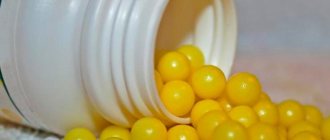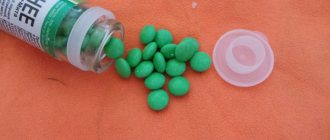Compound
| Set of dragees of different colors: | |
| red pellets (vitamins) | 1 dragee |
| active substances: | |
| retinol palmitate (vitamin A) synthetic concentrate oil form (1.7 million IU/g) | 2.94 mg |
| colecalciferol (vitamin D3) concentrate oil form (1 million IU/g) | 0.2 mg |
| ascorbic acid (vitamin C) | 60 mg |
| thiamine mononitrate (vitamin B1) | 1 mg |
| riboflavin (vitamin B2) | 1.2 mg |
| pyridoxine hydrochloride (vitamin B6) | 2 mg |
| cyanocobalamin 0.1% in mannitol | 3 mg |
| (corresponds to 3 mcg vitamin B12) | |
| nicotinamide (vitamin PP) | 13 mg |
| folic acid | 0.4 mg |
| calcium pantothenate (vitamin B5) | 5 mg |
| α-tocopherol acetate (vitamin E) | 10 mg |
| excipients: lactose monohydrate - 180 mg; orange oil 05073 - 5 mg; polysorbate 80 - 0.5 mg; glycerol - 3.45 mg; purified castor oil - 0.97 mg; sorbitol - 131 mg; dextrose (glucose) liquid (dry matter) - 150 mg; defoamer 1510 - 0.02 mg; magnesium stearate - 2.5 mg; dye Opalux AS-F-2833 G (crimson dye Ponceau 4R E124 + dye “Sunset” yellow E110) - 10 mg; emulsion wax - 2.5 mg; sucrose - up to 1200 mg | |
| blue jelly beans (minerals) | 1 dragee |
| active substances: | |
| calcium hydrogen phosphate dihydrate | 64.5 mg |
| (corresponds to calcium Ca 2+ - 15 mg and phosphorus P5+ - 12 mg) | |
| iron fumarate | 30.3 mg |
| (corresponds to iron Fe2+ - 10 mg) | |
| copper sulfate pentahydrate | 4 mg |
| (corresponds to copper Cu2+ - 1 mg) | |
| zinc sulfate heptahydrate | 13.3 mg |
| (corresponds to zinc Zn2+ - 3 mg) | |
| magnesium lactate dihydrate | 200 mg |
| (corresponds to magnesium Mg2+ - 20 mg) | |
| manganese sulfate monohydrate | 3.1 mg |
| (corresponds to manganese Mn2+ - 1 mg) | |
| sodium molybdate dihydrate | 0.22 mg |
| (corresponds to molybdate Mo6+ - 0.1 mg) | |
| excipients: lactose monohydrate - 151 mg; orange oil 05073 - 5 mg; polysorbate 80 - 0.5 mg; glycerol - 3.45 mg; purified castor oil - 0.97 mg; sorbitol - 105.7 mg; dextrose (glucose) liquid (dry matter) - 120.1 mg; defoamer 1510 - 0.02 mg; magnesium stearate - 2.5 mg; liquid paraffin - 10 mg; povidone - 2 mg; indigo carmine dye AS-20912 Blue (E132) - 10 mg; emulsion wax - 2.5 mg; sucrose - up to 1200 mg |
Duovit dragee No. 10x4
Name
Duovit dragees in blisters in packaging No. 10x4
Description
Red dragees: hard, smooth red dragees with a sweet and sour taste. Blue jelly beans: hard, smooth blue jelly beans.
Main active ingredient
Release form
4 blisters of 10 tablets each in a cardboard box with an insert. Each blister contains 5 red and 5 blue dragees.
Dosage
Adults and children over 10 years of age are recommended to take 1 red tablet (vitamins) and 1 blue tablet (minerals) per day.
pharmachologic effect
A combined preparation containing a complex of 11 vitamins and 8 minerals, which are important factors in metabolic processes. One red and blue dragee contains vitamins and minerals in quantities that satisfy the body's daily needs. For better absorption of the vitamin-mineral complex and preservation of the activity of the main components, vitamins and minerals are separated in tablets of different colors. Vitamins are contained in red pellets, minerals are contained in blue pellets. Vitamin A is involved in the synthesis of various substances (proteins, lipids, mucopolysaccharides) and ensures the normal function of the skin, mucous membranes, and the organ of vision. Vitamin D3 plays an important role in maintaining the balance of calcium and phosphorus in the body. With its deficiency, the calcium content in bone tissue decreases (osteoporosis). Vitamin B1 normalizes the activity of the heart and contributes to the normal functioning of the nervous system. Vitamin B2 promotes tissue regeneration processes, including skin cells. Vitamin B6 helps maintain the structure and function of bones, teeth, gums, affects erythropoiesis, and promotes the normal functioning of the nervous system. Vitamin B9 (folic acid) stimulates erythropoiesis. Vitamin B12 is involved in erythropoiesis and contributes to the normal functioning of the nervous system. B vitamins are involved in the formation of various enzymes that regulate different types of metabolism in the body. Vitamin PP (nicotinamide) is a coenzyme involved in protein metabolism during the synthesis of fatty acids and cholesterol, during the production of energy, and is necessary for the normal functioning of the central nervous system. Vitamin E is a natural antioxidant. Prevents increased blood clotting and has a beneficial effect on peripheral circulation. Participates in the synthesis of proteins and hemoglobin, the process of cell growth, the function of skeletal muscles, the heart and blood vessels, and the gonads. Vitamin C is involved in the oxidation of a number of biologically active substances, regulation of metabolism in connective tissue, carbohydrate metabolism, blood clotting and tissue regeneration, stimulates the formation of steroid hormones, and normalizes capillary permeability. Vitamin C increases the body's resistance to infections and reduces inflammatory reactions. Calcium is involved in the formation of bone tissue, blood clotting, transmission of nerve impulses, contraction of skeletal and smooth muscles, and normal heart function. It also promotes iron absorption. Magnesium is involved in the formation of muscle and bone tissue, and also takes part in protein synthesis. Iron is part of the hemoglobin molecule, participates in the transport of oxygen in the body and prevents the development of anemia. Phosphorus, along with calcium, is involved in the formation of bones and teeth, and is also involved in energy metabolism processes. Manganese promotes bone mineralization. Copper is necessary for normal red blood cell function and iron metabolism. Zinc is necessary for tissue regeneration and is part of some hormones, including insulin.
Pharmacokinetics
There have been no separate studies on the pharmacokinetics of Duovit tablets, however, the absorption, distribution and excretion of individual vitamins and minerals in the body are well known and described in the literature. Water-soluble vitamins (B vitamins, vitamin C and biotin) are well absorbed in doses within the recommended daily dose. Excess amounts are excreted in urine and, to a lesser extent, in feces. Vitamins of this group are stored in the body in limited quantities, so they must be constantly supplied with food to achieve the appropriate tissue concentration. In the presence of fats, vitamins A and D are well absorbed in the small intestine. Vitamin E absorption is relatively low (25% to 85% of the dose). These vitamins are stored in significant quantities in the liver and are therefore more toxic than water-soluble vitamins. If there is a lack of minerals and trace elements in the body, their absorption increases. Calcium, magnesium, copper, molybdenum ions are absorbed relatively well (up to 30% calcium ions and 20 to 65% magnesium ions), iron, zinc, and manganese are less absorbed. The average absorption of zinc from food ranges from 10 to 50%, iron from 1 to 30% and manganese 5%. The intake of large amounts of zinc ions from food reduces the absorption of iron and copper ions and promotes the absorption of manganese ions to a lesser extent, while magnesium ions have the opposite effect. Taking vitamins together may also affect mineral absorption. Vitamin C promotes the absorption of iron ions, vitamin D, calcium, phosphorus and magnesium ions. Iron ions that enter in excess accumulate in the liver, excess calcium, phosphorus and magnesium are excreted in the urine, excess zinc, cobalt and copper are excreted through the gastrointestinal tract.
Indications for use
Treatment of hypo- and avitaminosis caused by insufficient intake or increased need for vitamins.
Directions for use and doses
Adults and children over 10 years of age are recommended to take 1 red tablet (vitamins) and 1 blue tablet (minerals) per day. The pills should be swallowed whole with a small amount of water. It is recommended to take the drug after breakfast.
Use during pregnancy and lactation
Use during pregnancy is contraindicated and not recommended during breastfeeding. Vitamin A in doses greater than 1000 IU per day causes birth defects when taken during pregnancy. It is necessary to take into account that the vitamins and minerals taken are excreted in mother's milk, especially if the child receives other vitamin and mineral complexes. The risk of exposure to the nursing infant cannot be excluded and this must be taken into account if the infant is receiving any other dietary supplements. Taking high doses of vitamin B6 may inhibit milk production.
Precautionary measures
Before using vitamins, vitamin-mineral and/or mineral preparations, consult your doctor. Patients suffering from diabetes can be prescribed Duovit tablets, but it should be taken into account that the daily dose of the drug contains 1.6 g of sugar (one tablet contains approximately 0.8 g of sugar). Duovit should be taken after meals - otherwise, discomfort from the gastrointestinal tract may occur. The simultaneous use of Duovit with products containing vitamin A can lead to hypervitaminosis. Taking vitamins does not replace a balanced diet. Do not exceed the indicated dosage. High doses of some components, especially vitamin A, vitamin D, iron and copper, can be hazardous to health. Use with other vitamin preparations is not recommended to avoid overdose and side effects. Caution must be exercised when taking the drug in patients with impaired function or a history of liver disease, cholelithiasis, diabetes mellitus, gout, arrhythmia, migraine, alcohol abuse, gastric ulcer in the acute stage, the presence of neoplasms. Possible staining of urine yellow, which is an absolutely harmless factor and is explained by the presence of riboflavin in the drug. Special warnings regarding excipients. The drug contains lactose, sorbitol, glucose and sucrose. Patients with rare hereditary disorders such as fructose, galactose or sucrose-isomaltase intolerance, lactose intolerance or glucose-galactose malabsorption should not take the drug. Azo dyes E124 and E110 can cause allergic reactions.
Interaction with other drugs
There were no effects on the ability to drive a car or operate potentially dangerous machinery. Duovit is not recommended to be taken together with medications containing aromatic rings (for example, tetracyclines, quinolones, cholesterol) and with antacids. The combined use of minerals and antibiotics from the tetracycline group is not recommended, since their combined use reduces the absorption of the latter. When used together with antacids, the absorption of minerals slows down. If concomitant treatment is necessary, then the interval between taking tetracyclines or antacid medications and Duovit should be at least 3 hours. The simultaneous use of Duovit with products containing vitamin A can lead to hypervitaminosis. While taking the drug, you should refrain from drinking alcohol, since alcohol reduces the absorption of certain vitamins. Retinol reduces the anti-inflammatory effect of glucocorticoids. The combined use of levodopa with pyridoxine is not recommended, since the antiparkinsonian effects are neutralized by pyridoxine; this problem does not occur when combined with carbidopa-levodopa or peripheral decarboxylase inhibitors. Colchicine, cimetidine, calcium supplements, ethyl alcohol, neomycin, para-aminosalicylic acid, biguanides, cholesterol, potassium chloride and methyldopa reduce the absorption of vitamin B12. Serum concentrations of cyanocobolamin may be reduced by oral contraceptives. Folic acid may reduce plasma concentrations of anticonvulsants, in particular phenytoin, phenobarbital and primidone, resulting in a possible mutual reduction in clinical effectiveness. Therefore, patients receiving antiepileptic therapy may require dosage adjustments and careful medical supervision if taking folic acid. Medicines containing folic acid or its derivatives may reduce the effectiveness of methotrexate.
Contraindications
Hypersensitivity to the components of the drug. Hypervitaminosis A and D.
Compound
1 red dragee contains: Vitamin A (Retinolum) 5000 IU Vitamin D3 (Cholecalciferolum) 200 IU Vitamin C (Acidum ascorbicum) 60 mg Vitamin PP (Nicotinamidum) 13 mg Vitamin E (?-Tocopheroli acetas) 10 mg Calcium pantothenate (Calcii pantothenas) ) 5 mg Vitamin B6 (Pyridoxini chloridum) 2 mg Vitamin B2 (Riboflavinum) 1.2 mg Vitamin B1 (Thiamini nitras) 1 mg Folic acid (Acidum folicum) 0.4 mg Vitamin B12 (Cyanocobalaminum) 3 mcg 1 blue dragee contains : Calcium in the form of calcium hydrogen phosphate dihydrate 15 mg Phosphorus in the form of calcium hydrogen phosphate dihydrate 12 mg Iron in the form of iron (II) fumarate 10 mg Copper in the form of copper (II) sulfate pentahydrate 1 mg Zinc in the form of zinc sulfate heptahydrate 3 mg Magnesium in the form of magnesium lactate dihydrate 20 mg Manganese in in the form of manganese (II) sulfate monohydrate 1 mg Molybdenum in the form of sodium molybdate dihydrate 0.1 mg Excipients: lactose monohydrate, orange oil flavor, polysorbate 80, glycerin, purified castor oil, sorbitol, liquid glucose, antifoaming agent 1510, magnesium stearate, red dye (E124), orange dye (E110), indigotine dye (E132), capol 600 pharma, sucrose, liquid paraffin, povidone.
Overdose
Most symptoms related to overdose relate to the concomitant use of large doses of drugs containing one and/or more vitamins. Acute or long-term overdose can lead to hypervitaminosis A and D and hypercalcemia, as well as cause toxic effects of iron and copper. Atypical initial symptoms, such as sudden headache, confusion, and gastrointestinal symptoms such as constipation, diarrhea, nausea and vomiting, may be signs of acute overdose. Treatment: taking activated carbon orally, gastric lavage, symptomatic therapy.
Side effect
Side effects are classified into the following groups depending on the frequency of occurrence: very common (? 1/10), frequent (? 1/100 to
Storage conditions
Store at a temperature not exceeding 2-5 °C in a place protected from moisture and light. Keep out of the reach of children.
Manufacturer
KRKA, d.d., Novo mesto, Šmarješka cesta 6, 8501 Novo mesto, Slovenia.
Representative office of JSC "KRKA, d.d., Novo Mesto" in the Russian Federation/organization receiving consumer complaints: 125212, Moscow, Golovinskoye Shosse, 5, bldg. 1, fl. 22.
Tel.; Fax.
When packaging and/or packaging at a Russian enterprise, the following is indicated: KRKA-RUS LLC, 143500, Russia, Moscow region, Istra, st. Moskovskaya, 50.
Tel.; Fax.
or JSC "VECTOR-MEDICA", 630559 Russia, Koltsovo village, Novosibirsk region.
Tel/fax



